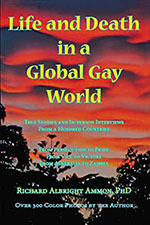Intro: In 1998, a magazine declared Indonesia as “descending into madness”–government instability, economic liability, racial attacks, religious violence. But an individual is not a label and a country is not a headline. I added Indonesia to my journey because that country of 14,000 islands swarms with beauty: flowers, mountain rainforests, ancient temples, artwork, architecture, exotic customs and swarthy friendly faces.
Also see:
Islam and Homosexuality
Gay Indonesia Stories
Gay Indonesia News & Reports 2004 to present
Gay Indonesia Photo Galleries

By Richard Ammon
October 2002
Updated May 2008
Changing History
During my previous stay in 1998 I saw protests, political street demonstrations and banner-waving motorcycle parades by government opponents. In Jakarta I was confronted with countless smashed windows from earlier riots that brought down President Suharto; there were burned out buildings especially in the Chinese areas. My Sheraton Hotel’s entrance atrium had large broken windows covered with colorfully painted plywood. Barbed wire barricades still were in place in front of the Hyatt. Soldiers and police patrolled the downtown with machine guns. Nevertheless I still had quality time visiting other parts of the country and finding the gay life there.
But by 2002, after new elections and a new president, Megawati Sukarnoputri (defeated in 2004), my friend Marcel Latuihamallo calmly said, “we are going through the biggest change since our independence in the 40’s”. We were sitting in his city-center office in Jakarta. “No government gives up power without a struggle because they are stupid and fearful. So much could be gained by being open to the people but dictators and the military don’t operate that way. So we have riots and killing…we’ll be okay, eventually.”
With a master’s degree from the University of Wisconsin, Marcel is director of Yayasan Mitra Indonesia, an HIV prevention and educational resource center that has also grown to become an important contact center for the lesbigay community in Jakarta. Marcel frequently gives lectures to public and professional and business groups about HIV and the several Mitra services such as anonymous HIV testing, counseling and referral services for medical, social and legal aid.
In this small four-room office on a narrow alleyway in the labyrinth of Jakarta’s dense downtown, I asked Marcel what ‘gay’ means in his Moslem-Buddhist-Hindu-Christian country.
“It’s considered a bad way of life but there is no bashing here. People see it like prostitution. But historically homosexuality–they didn’t call it that– was more accepted until the protestant Dutch arrived and stigmatized it.
Today there are no specific laws against homosexuality. There is no age of consent because homosexuals do not have any legal existence, in religious law nor in civil law.” As if to conform to such invalidating standards, gay life here is generally subdued and shrouded from public view. Much of gay social life takes place under the cloak of darkness, in certain places on certain nights.
Speaking perfect English, Marcel described some current same-sex customs still in place in the remote villages of Sulewesi and Java.  There, a ‘warok’ is a charismatic conductor of ceremonies who has one or several young male apprentices called ‘gemblaks’.
There, a ‘warok’ is a charismatic conductor of ceremonies who has one or several young male apprentices called ‘gemblaks’.
Being a gemblak was considered a privilege since it conveys status as well as the boys’ families receiving a dowry. The duties include caring for the warok in his household as well as assisting him in ceremonies, which sometimes require the apprentice to dress as women, in costumes and masks.
Sexual intimacy is usually assumed to be part of the arrangement, but not always. After about 17 years of age the boys give up their positions in the esteemed household and eventually go on to marriage–well trained in conjugal matters. Traditional legend does not associate this custom with homosexuality; it is simply ancient tradition. (See further comments below.)
Modern Conditions
In modern day Jakarta, however (2002), the invention of labels and modern customs–including a 90% Muslim population which proscribes homosexuality through an unwritten law–have stripped away all innocence and history as young gay men and women emerge in a milieu of potential fear, humiliation and name calling.
Being gay is now felt to be a curse by young gays first coming out. As they age, they hide their friendships and underground affairs, going off to meet and cruise anonymously at malls or parks. If they can afford it, many go to the increasing number of bars, clubs and discos on designated nights to socialize with other gay friends in the safety of the dimly lit bar area or the flashing strobes of the dance floor.
Marcel is fully out to his family and friends and is respected for his work and forthright courage. He was once interviewed for the magazine ‘Populaire’ and was asked to clarify the difference between ‘waria’ drag queens, transgenders, prostitutes and gay men. Undaunted he explained that warias were in it for fun, money and sex; the trannies enjoyed the money and fun; the hustlers liked the money and the gay men went for the fun!
 An important development that has emerged from the energy of Mitra is IPOOS, a loosely organized social and entertainment group that presents very popular drag-comedy shows with lip-sync performances.
An important development that has emerged from the energy of Mitra is IPOOS, a loosely organized social and entertainment group that presents very popular drag-comedy shows with lip-sync performances.
In recent year, as Indonesian experienced more prosperity and the expansion of a more tolerant middle class, such overtly gay events and venues have quietly become ‘cool’ places to see and be seen.
IPOOS now puts out a monthly magazine with information about local events, international happenings (including Gay Games V), book reviews, discos, HIV stats, national organizations as well as personal ads–not to mention a few eye-pleasing photos (men only).
As for lesbians in Indonesia, the scene is very closeted. Most lesbians are married to Muslim husbands and their lives highly confined. In the bigger cities, they have more freedom to form discreet friendships and some organizations have been formed: Indonesian Lesbians Connecting and Growing is a lesbian league in Bali. In Jakarta, Mitras helps women find resources and support for friendship and activities.
In recent months graphic media images of violent racial strife between Chinese-descent Indonesians and indigenous Indonesians have served well to stigmatize the country as a loose cannon. Expansive headlines about brutal attacks on individuals and businesses have further amplified the rift between these two major groups.
Many Chinese-Indonesians are resented because they are effective business people and tend to have more money and thus more power; they are the wheeler-dealer merchant and banking class who are portrayed as driving around in big cars and lording over Indonesian servants.
One afternoon my taxi was stopped at a traffic light in downtown Jakarta. Surrounded by a couple dozen Indonesians driving fuming motorbikes and old trucks waiting for the light was a big shiny Rover Discovery driven by an obviously Chinese-Indonesian–windows rolled up and air-conditioning on. There is some truth to the image but most people do not choose violence in response.
Gay Bonds
As I have been told before in other racially tense countries, there tends to be much less conflict or bigotry among ethnic gay groups, in this case between Indonesian and Chinese-Indonesian gays. “There is more of a bond there. Our community knows discrimination and prejudice very well from the outside, so you don’t find it much inside the gay scene,” declared Marcel.
 The gay scene in Indonesia is not very diverse–a few discos and fewer social organizations, but it is fairly widespread. The country is so large (14, 000 islands with over 200 million people) there is little support to be found in the remote reaches and small islands.
The gay scene in Indonesia is not very diverse–a few discos and fewer social organizations, but it is fairly widespread. The country is so large (14, 000 islands with over 200 million people) there is little support to be found in the remote reaches and small islands.
It’s in the urban areas where precious contact organizations, groups and offices are located. One of the most important is Gaya Nusantara in Surabaya (in central Java) founded by another leader, Dede Oetomo. Gaya coordinates the Indonesian lesbian and gay network, consisting of lesbigay organizations and individual activists throughout the nation. The second is Marcel’s IPOOS/Gaya Betawi for the Jakarta metropolitan area and Sumatra.
Because the country’s night scene is often limited to weekends, most of the urban discos are mixed with lesbian women although very much in the minority. In only a handful of the cities like Jakarta, Bali and Surabaya are lesbian-night events held.
We stayed in Bali for a few days, home to numerous gay cafes and bars as well as the organization Gaya Dewata. One of the best known gay cafes, Luna, where the fashionably semi-attired, gay and straight, brunch and dine. On my visit, unfortunately it was filled with lot of hard drinking rowdy Aussies, so I didn’t stay long.
Night Show
My one excursion into the iniquitous gay nightlife began about midnight on a Friday in Jakarta. The New Moonlight Disco was a drama unto itself. A street ‘happening’ formed spontaneously outside the undecorative and anonymous entrance on gay night. Queens in dark drag slinked against car fenders posing seductively. A pair of street-smart ten-year-old boys tried to pimp for them with me.
Gay guys (mostly) in tight tanks and jeans hung around watching the waria queens, us, the kids and others arriving two at a time on their motorbikes. It was time to see and be seen. Preening, posturing, checkout out the crowd. We felt a bit obvious–white and tall.
 I left the street circus and went upstairs to a black cavernous room lit by blacklight and flashing colored dance lights. It looked much like any other gay bar/disco operating on a tight budget: dark walls, dim around the edges where guys clutched beer bottles and cruised. Others moved with the beat of the inevitable brain-bashing loud music.
I left the street circus and went upstairs to a black cavernous room lit by blacklight and flashing colored dance lights. It looked much like any other gay bar/disco operating on a tight budget: dark walls, dim around the edges where guys clutched beer bottles and cruised. Others moved with the beat of the inevitable brain-bashing loud music.
The dance floor throbbed with bodies bobbing, twisting and hopping. Away from the body crowd a few single dancers swaying by themselves; the ones in white jeans and tanks glowed under the blacklights. I watched for a while as one sweet-lipped loner locked eyes with westerner and soon they were grinding away only to disappear a short while later. In such things, we are far more similar than different across the world.
Despite exaggerated media hype, tense economic conditions and scattered extremist attacks on ethnic and religious target groups, most Indonesians continue in their work and love; lesbigays are no exception and weekend disco nights pulse with the beat–and with hope.
The Old Ways
Some of the links that accompany this story, on the left under Literature, connect with lengthy discussions about the ancient rituals involving the warok and gemblak male relationship mentioned above. I encourage further reading to fully understand the whole tradition and nature of this master/apprentice arrangement.
Those of us from the modern western gay tradition who understand homosexuality as an inborn trait that endows us with a bi-polar sensibility (male-female) will find this tradition quite intriguing.
The East Javanese town of Ponorogo has an historical reputation for the magical powers and sexual potency of its inhabitants. Two figures central to the legend and rituals of this culture are the warok and gemblak. Due to their alleged martial and magical abilities, the warok were often advisers and strong men for the local ruler, and hence free from the obligations of ordinary villagers.
The warok was rarely part of the official government, and thus played a somewhat ambiguous role, residing in the margins of social and political life. On the one hand his standing amongst villagers made his support crucial for any aspiring ruler and he often acted as an agent for higher authorities.
At the same time, however, his unofficial status also made him a potentially dangerous adversary and troublemaker. The warok was a power broker, an intermediary between higher and lower powers, in the concrete and cosmological sense. His authority was intensely personal, depending on mastery of invulnerability, martial arts, magic, and religious knowledge, as well as the fear and admiration with which villagers regarded him.
In order to pass on his knowledge and skill, a warok sought out certain younger men, a gemblak, whom he considered as possessing the traits necessary for this alternative and important role in the tribe. Ancient legend tells the story of the son of the king of Ponorogo leaving home to learn all about martial arts under the guidance of a holy man.  Subsequently, the two men would become intimate trusted friends. This type of filial and, presumably, sexual exile within a religious and martial arts context, is a common and a recurring element in Javanese and Balinese narratives.
Subsequently, the two men would become intimate trusted friends. This type of filial and, presumably, sexual exile within a religious and martial arts context, is a common and a recurring element in Javanese and Balinese narratives.
New Interpretations
Today that tradition is carried on by dance troupes who compete and perform during the annual Reyog Ponorogo festival. The leader of the dance troupe and the person who usually carries the Singa-Barong mask is the warok, renowned for his strength.
One of the most intriguing elements of the Reyog dance are the warok’s companions, the handsome androgynous gemblak soldiers, riding their hobby-horses to the rhythm of the accompanying music. If warok bring to Reyog connotations of excessive masculinity, gemblak, in contrast, bring to their military role connotations of grace and femininity.
Unfortunately, in modern popular discourse, armed with labels and assumptions, gemblak are now being seen as ‘transvestites’ and warok as ‘homosexual,’ which they politely deny. Instead, they claim their relationship to be a part of a long-standing tradition, which has little if anything to do with transvestitism or homosexuality.
Whether they can be called a homosexual community is questionable. They don’t call themselves homosexuals; they don’t identify themselves as homosexuals, such as one finds in the West or in modern urban Indonesia. They would call themselves warok-gemblakan in a tradition of prowess and of performing arts. This is where Reyog Ponorogo festival comes in–it disclaims modern ‘gay’ identifications.
Dede Oetomo, an activist and leader of the modern gay community in Java, has claimed, “seen from the outside, from what I have read, from what I have seen in pictures, they live like a homosexual community anywhere. The combination of old, powerful men and poor, but handsome young men and boys seemed like a questionable combination of power.”
With these ‘modern structuralism’ concepts and categories, an ancient legend has been confounded by a modern paradigm; there’s no elegant way of depicting the whole truth of the relationship between warok and gemblak. Natives profess the relationship is not homosexual, conventional, dualistic or transvestite.
To resolve this dilemma, one could question the truthfulness of the Reyog informants (who reject modern labels), or we can resist naming in order to revere the beauty and mystery of a legend steeped in the magic of human androgyny, power and wisdom.
















